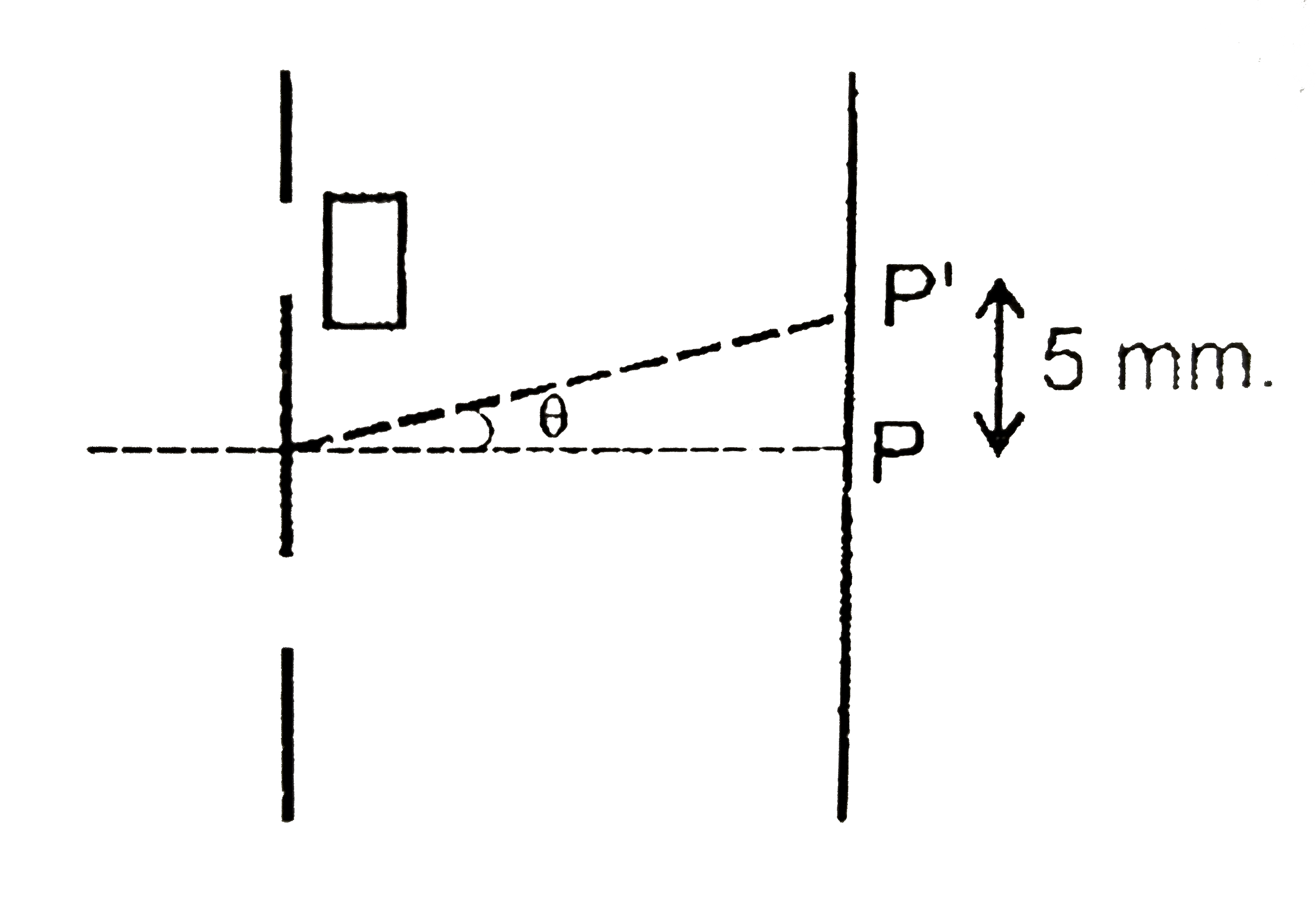YDSE is conducted using light of wavelength 6000Å to observe an interference pattern. The slits are 2mm apart. The fringes are observed on a screen 10cm away from the slits. When a film of some material 0.5mm thick was placed over one of the slits, the fringe pattern shifted by a 5mm. What is the refractive index of the material of the film ?
1.2
0.6
2.4
1.5
The correct Answer is:A
Clearly the central maxima at P(initially) shifts to P' where PP'=5mm.
So now, path difference at P' must be zero.
⇒dsinθ=(μ−1)t
⇒dtanθ=(μ−1)t
μ=1+d.(PP')Dt,getμ=1.2

Topper's Solved these Questions
- WAVE OPTICSBOOK - RESONANCE ENGLISHCHAPTER - WAVE OPTICSEXERCISE - Exercise-2 (Part-1)
10 Videos
- WAVE OPTICSBOOK - RESONANCE ENGLISHCHAPTER - WAVE OPTICSEXERCISE - Exercise-2 (Part-2)
5 Videos
- WAVE OPTICSBOOK - RESONANCE ENGLISHCHAPTER - WAVE OPTICSEXERCISE - Exercise-1 (Part-1)
13 Videos
- WAVE ON STRING BOOK - RESONANCE ENGLISHCHAPTER - WAVE ON STRING EXERCISE - Exercise- 3 PART II
7 Videos
Similar Questions
Interference fringes were produced in Young's double-slit experiment using light of wavelength 5000Å. When a film of thickness 2.5×10−3cm was placed in front of one of the slits, the fringe pattern shifted by a distance equal to 20 fringe-widths. The refractive index of the material of the film is
View SolutionIn Young.s double slit experiment, blue-green light of wavelength 500nm is used. The slits are 1.20mm apart, and the viewing screen is 5.40m away from the slits. What is the fringe width.
View Solution
Knowledge Check
Interference fringes were produced in Young's double slit experiment using light of wavelength 5000 Ã…. When a film of material 2.5×10−3cm thick was placed over one of the slits, the fringe pattern shifted by a distance equal to 20 fringe widths. The refractive index of the material of the film is
A1.25B1.33C1.4D1.5In Young's double-slit experiment, the slit are 0.5 mm apart and the interference is observed on a screen at a distance of 100 cm from the slits, It is found that the ninth bright fringe is at a distance of 7.5 mm from the second dark fringe from the center of the fringe pattern. The wavelength of the light used in nm is
A25007B2500C5000D50007A beam of light of wavelength 600 nm from a distant source
falls on a single slit 1.0 mm wide and the resulting diffraction pattern is
observed on a screen 2m away. What is the distance between the first dark
fringe on either side of the central bright fringe?A1.2cmB1.2mmC2.4cmD2.4mm
A single slit of width 0.1mm is illuminated by parallel light of wavelength 6000Å, and diffraction bands are observed on a screen 40cm from the slit. The distance of third dark band from the central bright band is:
View SolutionLaser light of wavelength 630 nm is incident on a pair of slits which are separated by 1.8 mm. If the screen is kept 80 cm away from the two slits, calculate :
fringe separation i.e., fringe width
View SolutionLaser light of wavelength 630nm incident on a pair of slits produces an interference pattern where bright fringes are separated by 8.1mm. Another light produces the interference pattern, where the bright fringes are separated by 7.2mm. Calculate the wavelength of second light.
View SolutionA beam of light of wavelength 600 nm from a distant source
falls on a single slit 1.0 mm wide and the resulting diffraction pattern is
observed on a screen 2m away. What is the distance between the first dark
fringe on either side of the central bright fringe?
View SolutionIn Young’s double slit experiment, using light of wavelength 600 nm, 10th bright fringe is obtained on a screen, 3mm from the centre of the pattern. If the screen is 120 cm away from the slits, calculate:
(i) Distance between the two slits,
(ii) Fringe width, i.e. fringe separation.
View Solution
